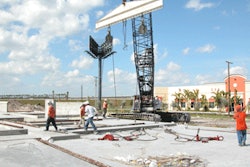A few years ago the Center for Construction Engineering and Management at the University of Michigan conducted a time study to determine the amount of time construction workers are simply waiting to work. The average time lost waiting for equipment, materials, tools, and information varied among the construction disciplines.
Bricklayers waited on average about 45 minutes, carpenters about 62 minutes, roofers about 75 minutes, electricians about 80 minutes, and plumbers about 83 minutes. While these times are not necessarily indicative of the time pavement maintenance people may spend waiting for materials, equipment, or directions everyday (hopefully not!) this time study does raise an important issue. Waiting can and does cost the contractor and the customer.
Consider how much time each day your crews are simply waiting. What are the causes for such waiting? Let's examine a few causes in this article and calculate a possible cost for the waiting period. We'll then offer some time management tips.
First, let's consider possible reasons that would cause anyone in an organization, directly involved with completing work, to be found waiting:
- Equipment breakdown
- Employees late to work
- Gassing up vehicles
- Late delivery materials
- Jobsite not accessible or prepared
- Owner didn't unlock premises
- Emptied inventory of supplies
- Employee forgot important tool or equipment
- No directions to jobsite
- Crew waiting for supervisor to return from lunch
While the reasons for any work delay can vary from day to day the costs incurred remains painfully in place. It is easy to state that you can never replace lost time. "Downtime" in construction, for any reason, normally costs you money and is not recoverable from the customer.
What are the costs associated with having workers waiting around? Well, let's take a look at one situation that can provide you with a method to calculate the financial costs for waiting for work to begin or resume.Consider a pavement maintenance contractor who suddenly finds his five-man crew without hot asphalt to lay. There was a mix-up in the directions given to the material driver and the crew is standing around for one hour before the material shows up. Let's calculate the potential costs to the contractor having five workers standing around for one hour using an average hourly rate of $20 (includes FICA etc.).
5 workers x 1 hour waiting = 5 total hours spent waiting
5 hours x $20 per hour = $100
Our cost for having labor waiting on materials is $100. Are there other costs? That depends on the step in the process. For example, if the crew needed this missing material to finish out a section then the hour wait might cause some consistency problems with the asphalt already placed.
You might think one mistake costing $100 is no big deal. And you're right, if this only happened once in a while. Unfortunately, problems like this can shift for one reason or another, leaving employees waiting five minutes here and 15 minutes there.
One more calculation worth noting: Let's imagine that every employee you have spends approximately 15 minutes a day looking for "stuff" such as brooms, brushes, tips, shovels, safety tape, time cards, etc. Now, consider you have 10 employees paid an average of $10 an hour. Let's calculate the average cost for one year:
10 employees x 15 minutes/day x 200 work days/year = 30,000 minutes/year
30,000 minutes/year ÷ 60 minutes/hour = 500 hours/year
500 hours/year x $10/hour = $5,000/year
Therefore, by having each employee looking for "stuff" for only 15 minutes per day, we can experience $5,000 in fewer profits for the year. While this amount may not be terribly great for some contractors, it is still a cost that is paid due to poor organization and planning. If your company is larger, refigure the numbers to determine what your potential costs would be. (The actual time wasted by field workers is closer to 60-90 minutes per day. Ouch!)
Much of the costs associated with waiting employees are due to poor leadership. Contractors must do a better job of not only providing more clear direction and instruction but also involving their workers in learning how to determine direction for themselves. Consider a few techniques you can integrate into your own approach to maximize the amount of time spent by workers actually working.
Develop a weekly "look ahead" schedule. This planner should be completed by the Friday before the next week. This tool should identify what jobs will be performed, what resources will be needed, what day the work will be performed, and who will be completing the work.
Conduct daily "huddles." Begin each day with a short informational meeting to remind and clarify for everyone who is doing what, when, and how. Huddles should be kept to three to five minutes. This also acts as a verbal daily planner.
Make important telephone numbers available. Contractors and their supervisors should not be the only employees with critical telephone numbers. A laminated card of all important numbers can be provided to each employee or attached to each company vehicle. Not having the right phone numbers at the time they are needed adds greatly to time waste.
Job cost & track performance. This will help you improve performance and help keep more workers educated about what they are doing, what they will need to do it, and how they will go about doing it. Both efforts drive greater accountability and enhance the focus of your employees. Much of the reason behind time waste lies in the lack of attention to detail that some employees exercise.
Create job tools & materials list. This should represent a document that can be completed for every job. The document should itemize every tool and material needed to complete each job. It should also include the space to identify what tools need maintenance, replacement, etc.
Make preventive maintenance a priority. Equipment that runs without breaking down means more profits and happier employees. The machine or truck that breaks down every other week tends to wear the employees out, casting doubt in their minds about your commitment to helping them work without problems. Put all your equipment and vehicles on a preventive maintenance schedule and watch how much more work you get done.
"Stage" your jobsite at the end of each day.Do you need diesel in the vehicle before starting up again tomorrow? Fill up before calling it quits today. Need hand tools or that roller loaded on your trailer before pulling out of your shop in the morning? Have everything loaded on the trailer bed tonight before you send the troops home. Getting the job or worksite ready for the next day's performance will save you time the following morning and warn you if you are missing anything.
Brad Humphrey is president of Pinnacle Development Group, a consulting and educational company for contractors. For information visit www.pinnacledg.com.




















